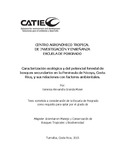| dc.contributor.author | Granda Moser, Vanessa A. | |
| dc.date.accessioned | 2015-09-22T21:11:17Z | |
| dc.date.available | 2015-09-22T21:11:17Z | |
| dc.date.issued | 2015 | |
| dc.identifier.uri | https://repositorio.catie.ac.cr/handle/11554/7255 | |
| dc.description | Tesis (Mag. Sc. en Manejo y Conservación de Bosques Tropicales y Biodiversidad) -- CATIE. Escuela de Posgrado. Turrialba (Costa Rica), 2015. | |
| dc.description.abstract | La recuperación de bosques secundarios en pastizales abandonados se ha convertido en un proceso clave para la conservación y manejo de agro paisajes, ya que están estrechamente ligados al mantenimiento de la biodiversidad forestal a través del tiempo. No obstante a pesar de la importancia que tienen estos ecosistemas para establecerse en áreas perturbadas, son deficientes los conocimientos sobre los factores que interactúan en el establecimiento de las comunidades vegetales de segundo crecimiento. En 53 parcelas temporales de muestreo de 0,12 ha, ubicadas en un rango altitudinal entre 54 a 828 m.s.n.m. se estudiaron todos los árboles ≥ 10 cm dap con el objetivo de contribuir al conocimiento sobre la distribución, composición florística, estructura y diversidad de los bosques secundarios, para conocer su potencial forestal y establecer lineamientos de manejo. Se identificó más de 150 especies de árboles, agrupados en tres tipos de bosques a través de análisis multivariados. A partir de esta clasificación, los bosques fueron comparados en relación a su composición, estructura, riqueza, diversidad y edad de abandono. El análisis de variación de composición florística en función de variables de clima, suelo, distancia geográfica y altitud, evaluado por medio de partición de la varianza indica que el espacio es el principal mecanismo de recambio de especies en el gradiente altitudinal, seguido por el clima. Esto sugiere que la dispersión es el principal mecanismo para el recambio de especies y el mantenimiento de la diversidad beta en la explicación de composición florística de los bosques secundarios en el gradiente, señalando además que con respecto al uso anterior del suelo, la carga animal y ocurrencia de incendios tienen influencia sobre la composición de la vegetación. | es_ES |
| dc.description.abstract | The recovery of secondary forests on abandoned pastures has become a key process to conservation and management of agricultural landscapes, as they are closely linked to the maintenance of forest biodiversity through time. However, despite of the importance of these ecosystems to settle down in disturbed areas, the knowledge of factors that interact in the establishment of plant communities of second growth still remains deficient. In 53 temporary sample plots of 0.12 ha, located at an altitude range between 54-828 m a.s.l, we studied all trees ≥ 10 cm dbh in order to contribute to the knowledge on the distribution, species composition, structure and diversity of secondary forests for their forestry potential and introducing management guidelines. Over 150 species of trees were identified grouped into three types of forests through multivariate analyzes. Based on this classification, the forests were compared in relation to the variables of composition, structure, richness, diversity and age of abandonment. The analysis of variation in species composition in terms of climate, soil variables, altitude and geographic distance, evaluated by variation partitioning indicates that space is the main mechanism of species turnover in the altitudinal gradient, followed by climate. This suggests that dispersion is the main mechanism for species turnover and maintenance of beta diversity in explaining floristic composition of secondary forests in the gradient, further noting that the previous land use, stocking rate and fire occurrence have influence on vegetation composition. | en_EN |
| dc.language.iso | es | es_ES |
| dc.publisher | CATIE, Turrialba (Costa Rica) | es_ES |
| dc.subject | BOSQUE SECUNDARIO | |
| dc.subject | COMPOSICION BOTANICA | |
| dc.subject | BIODIVERSIDAD | |
| dc.subject | ESTRUCTURA DEL RODAL | |
| dc.subject | SUCESION SECUNDARIA | |
| dc.subject | FACTORES AMBIENTALES | |
| dc.subject | TIERRAS ABANDONADAS | |
| dc.subject | REFORESTACION | |
| dc.subject | CONSERVACION DE LA DIVERSIDAD BIOLOGICA | |
| dc.subject | ORDENACION FORESTAL | |
| dc.subject | ARBOLES FORESTALES | |
| dc.subject | ESPECIES | |
| dc.subject | COSTA RICA | |
| dc.title | Caracterización ecológica y del potencial forestal de bosques secundarios en la Península de Nicoya, Costa Rica, y sus relaciones con factores ambientales | es_ES |
| dc.type | Tesis de maestría | es_ES |
| dcterms.rights | acceso abierto | es |
| dc.identifier.publisher | CATIE | es_ES |
| dc.identifier.publication | CATIE | es_ES |


